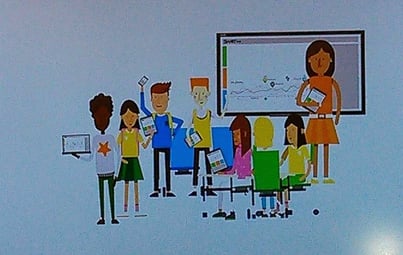
I work to help schools integrate technology into their instructional models, I am continually inspired by the promise of digital technology to enable collaboration among teachers across the school. It’s not clear to me if today’s technology providers are building their programs with teacher collaboration in mind or if the collaboration is a positive, yet unintended consequence discovered by clever teachers. However it came about, I am certain that this sort of cross-classroom collaboration is key to delivering better student-centric instruction.
Of course, the use of technology to improve efficiency of time-consuming tasks like grading and assessments is hardly new - just think of Scantron and how revolutionary that was when first introduced. Yet, earlier technologies such as Scantron didn’t readily facilitate cross-class teacher collaboration. Today, digital content providers like Mastery Connect and Goalbook to name two, are making robust data sets available to groups of teachers. With the shared data, teachers can now collaborate with each other online, across classrooms and disciplines, to gain a more holistic understanding of an individual student’s performance.
Before these high-tech tools were available, when data came only from paper-based assessments, it was very difficult and time consuming for teachers to collaborate around a single student. Now, with shared data sets, enabled by technology, multiple teachers can have a window into a student’s performance, across disciplines. The result, from what I’ve seen, is that learning challenges or strengths can be detected and addressed earlier.
Let’s think about a possible instructional scenario. The data shows that a student is struggling with literacy and also, lately, she has been having trouble with math. While her learning challenges are showing up in her grades in the individual classes, the detailed data set compiled from all her classes illuminates that the root of her recent trouble in math is not numbers, but words, as in word problems. Her struggle in reading is now manifesting itself in math. As a result of this information, the math and the reading teachers can collaborate to build a personalized plan for this student. This sort of data-driven discovery could very well change the way instruction is delivered and how intervention is addressed, ultimately leading to higher student achievement.
Another outcome I find encouraging is the way that technology can help transcend the physical barriers of the traditional school site. We tend to think about schools made up of individual rooms with a teacher upfront and in control of his or her classroom. This traditional classroom set-up, while appropriate for one-to-many instruction, isn’t ideally structured to encourage cross-classroom collaboration or to support a highly student-centric approach. Smart integration of the right technology tools, which do invite collaboration, can virtually break down the walls between classrooms.
I would like to see more digital content providers develop products that allow teachers to set goals and collaborate around individual students across classrooms. Unfortunately, many products still mimic the architecture of the traditional school, serving products that allow a single teacher to “teach” a course, with access for administrators, but no access for other teachers or tools for collaboration. The good news is, that’s starting to change. Innovation in online social tools and virtual forums from providers such as GoalBook and Class Dojo are especially encouraging because they involve not only multiple teachers but also the students themselves.
There is so much more that technology can do to help groups of teachers more easily and more frequently access performance and to use the information to drive improvements in student performance. And that’s what gets me excited. I am optimistic that we will see a new array of technology tools that positively disrupt our traditional education model and facilitate teacher collaboration around individual students across classrooms. Eventually, I hope, the classroom wall will symbolize not a wall, but a window.



